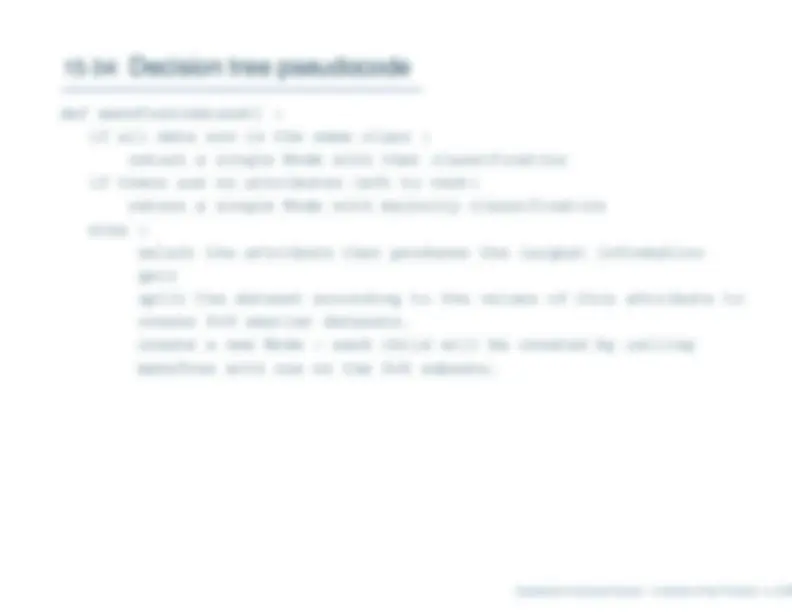




































Study with the several resources on Docsity

Earn points by helping other students or get them with a premium plan


Prepare for your exams
Study with the several resources on Docsity

Earn points to download
Earn points by helping other students or get them with a premium plan
Community
Ask the community for help and clear up your study doubts
Discover the best universities in your country according to Docsity users
Free resources
Download our free guides on studying techniques, anxiety management strategies, and thesis advice from Docsity tutors
This document from the university of san francisco's computer science department covers the concept of learning agents, their performance standards, and the process of learning, including the acquisition of new knowledge and changes in behavior. It also delves into decision trees, their structure, and the process of constructing and using them for decision-making and classification. The document further explores different types of learning tasks and the goal of induction.
Typology: Study notes
1 / 42

This page cannot be seen from the preview
Don't miss anything!



































Artificial Intelligence Programming
Department of Computer Science — University of San Francisco – p. 1/
∧^ warm
→^ P layT ennis
◦^ cool
∧^ (rain
∨^ strongW ind
P layT ennis
Department of Computer Science — University of San Francisco – p. 2/
Department of Computer Science — University of San Francisco – p. 4/
Environment
Sensors Performanceelement changesknowledge Critic feedback Learningelementlearninggoals Problemgenerator
Actuators
Department of Computer Science — University of San Francisco – p. 5/
deduction
◦^ Advantage: deduction is sound, assuming your knowledgeis correct. • Sometimes, you may not have general information about aproblem. • Instead, you might have
data
about particular instances of a
problem. • the problem then is to figure out a general rule from specificdata. • This is called
induction
◦^ Problem: induction is not sound.
Department of Computer Science — University of San Francisco – p. 7/
Department of Computer Science — University of San Francisco – p. 8/
Department of Computer Science — University of San Francisco – p. 10/
reward
for taking an action.
◦^ May not know how optimal a reward is. ◦^ Will not know the “best” action to take ◦^ Our agent might be presented with a Sunny, Hot, Lowhumidity, Strong wind day and asked to choose whether toplay tennis. ◦^ It chooses ’yes’ and gets a reward of 0.
Department of Computer Science — University of San Francisco – p. 11/
classification
◦^ For a given input, determine which class it belongs to. • Programs that can perform this task are referred to as classifiers
Department of Computer Science — University of San Francisco – p. 13/
f^ that tells us how to classify a set of inputs.
-^ An example is a set of inputs
x^ and the corresponding
f^ (x)^
the class that
x^ belongs to. ◦^ << Overcast, Cool, Low, W eak >, playT ennis > • We can define the learning task as follows: ◦^ Given a collection of examples of
f^ , find a function
H^ that
approximates
f^ for our examples.
◦^ H^ is called a
hypothesis
Department of Computer Science — University of San Francisco – p. 14/
bias.
-^ All learning lagorithms have a bias; identifying it can help youunderstand the sorts of errors it will make. •^ Examples:^ ◦^
Occam’s razor ◦ Most specific hypothesis. ◦ Most general hypothesis. ◦ Linear function
Department of Computer Science — University of San Francisco – p. 16/
learning algorithm is presented with a large set of data all at once and selects a single hypothesis. • An^ incremental
learning algorithm receives examples one at a time and continually modifies its hypothesis.^ ◦^ Batch is typically more accurate, but incremental may fitbetter with the agent’s environment. • An^ active
learning agent is able to choose examples.
-^ A^ passive
learning agent has examples presented to it by an outside source.^ ◦^ Active learning is more powerful, but may not fit with theconstraints of the domain.
Department of Computer Science — University of San Francisco – p. 17/
Feathers? Yes^
No
Does it Fly?^
Does it Eat Meat?
No Yes Yes Does it havelong legs?^
Albatross Yes Ostrich No No Penguin
Does it haveBlack Stripes?Yes
No Tiger
Does it havea long neck? Cheetah
Yes^
No Giraffe^
Zebra Department of Computer Science — University of San Francisco – p. 19/
No^ Yes No Yes
No^ Yes^ No^
Yes
None^ Some
Full >60 30-^
10-^
0- No^ Yes
Hungry?^ Alternate? Reservation? Bar?^
Raining?
Patrons?^ Alternate?^ Fri/Sat? No^ Yes^ No^
Yes Yes^ Yes^ No
Yes No Yes Yes No Yes WaitEstimate? No Yes Yes No • Note that
not^
all^ atributes
are used.
Department of Computer Science — University of San Francisco – p. 20/